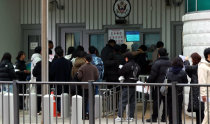Farmers Want Snow Aid from Government
Farmers Want Snow Aid from Government
Posted December. 23, 2005 03:00,
The fields surrounding Deokrye-ri, Naju in South Jeolla Province, looked like they were covered with white carpets because of snow that has fallen since dawn on December 21.
If we are compensated early, we could at least plant another crop, said farmers.
With snow up to the knee, it has been difficult to distinguish between roads and fields. Many greenhouses covered with snow looked like giant igloos made by Eskimos.
On December 22, the residents of the villages were pumping out water pools between greenhouses. That is because greenhouses made out of plastic cannot withstand the weight of the water accumulated by the melting snow.
I need to quickly clean up the frozen red peppers and plant another crop, but since compensation is not quickly forthcoming, I cant do anything but worry.
Fifty-one-year-old farmer Lee Young-bal who grows red peppers in a 500-pyong greenhouse said, Due to procedures such as damage assessment from the governments joint assessment team, and then waiting, it usually takes 50 days for the money to come. I need to plant my radishes in two weeks, but I dont think the money will come until then.
As of December 22, the damages caused by the massive amount of snow that has fallen since December 4, are estimated to be 42.537 billion won in the Naju City area alone. This figure is 27 percent of the damages caused in the entire South Jeolla area, amounting to as much as 156.224 billion won.
Out of a total of 15,000 farms, 2,453 have suffered losses. During that period, 28,000 personnel composed of government employees and soldiers were mobilized, but only 58 percent of the damaged greenhouses have been cleaned up and restored.
Villagers who were gathered in front of Sanpo Nonghyup all said that the governments compensation was not sufficient enough to help them much.
In the case of plastic greenhouses, the hardest hit facilities, if a greenhouse is over two hectares, the farmer is granted a loan to cover 70 percent of his or her costs, while 30 percent comes from his or her own pockets. There is no governmental or regional financial aid, so in order to restore the damage, farmers have no choice but resort to debt.
One villager suggested the expansion of tax-free oil supplies.
Seo Yong-yul, a 59-year-old farmer, said, In order to prevent the greenhouses from collapsing, we melt the snow by turning on heaters. But with the cost of tax-free oil up 15 percent compared to last year, we are faced with another burden.
Kang Byung-nam, who farms red peppers in the nearby village of Shinpyong, suffered losses of 100 million won when all nine of his greenhouses collapsed after the seven snowstorms that hit his town since December 4. He is devastated, since he is already in debt for tens of millions of dollars due to damage caused by floods last summer.
Kang commented, Every year I planted red peppers, then cabbage, and then watermelon, but because of this snow, my cabbage crops will be ruined. If there are no special measures forthcoming from the government, there wont be anyone to farm.
Najus specialty fruit, pears, werent able to avoid the snow either. Seo Sang-kis orchard in Kumok-ri, had over320 pear trees, all 18-year-old, and all snapped at the stump.
The 20 million won net that he built above the trees seven years ago in order to protect his pears from magpies could not hold the weight of the snow and fell down onto trees. His hopes for a good harvest also fell.
Seo who earned 30 million won annually from his orchard, said, If I root up the broken trees and plant 3-year-old trees, I will be able to reap something in seven years.
Seung-Ho Jung shjung@donga.com




![화장실 갇혔을 때 생존법…“최후에는 변기뚜껑” [알쓸톡]](https://dimg.donga.com/c/138/175/90/1/wps/NEWS/IMAGE/2025/12/26/133042007.3.png)

![보일러 풀가동해도 춥다?…난방비 폭탄 범인은 ‘이것’ [알쓸톡]](https://dimg.donga.com/c/138/175/90/1/wps/NEWS/IMAGE/2025/12/24/133029046.3.png)
